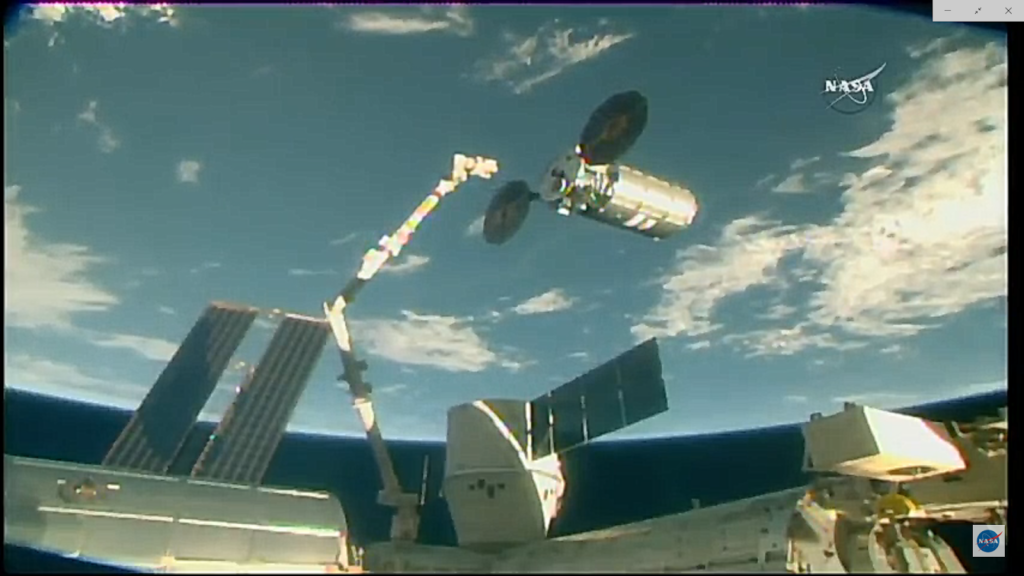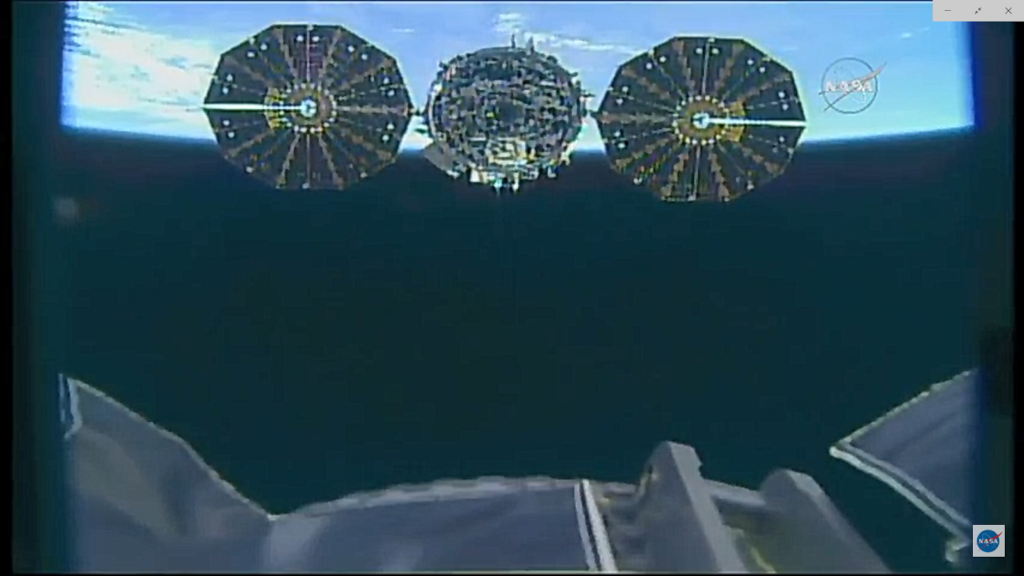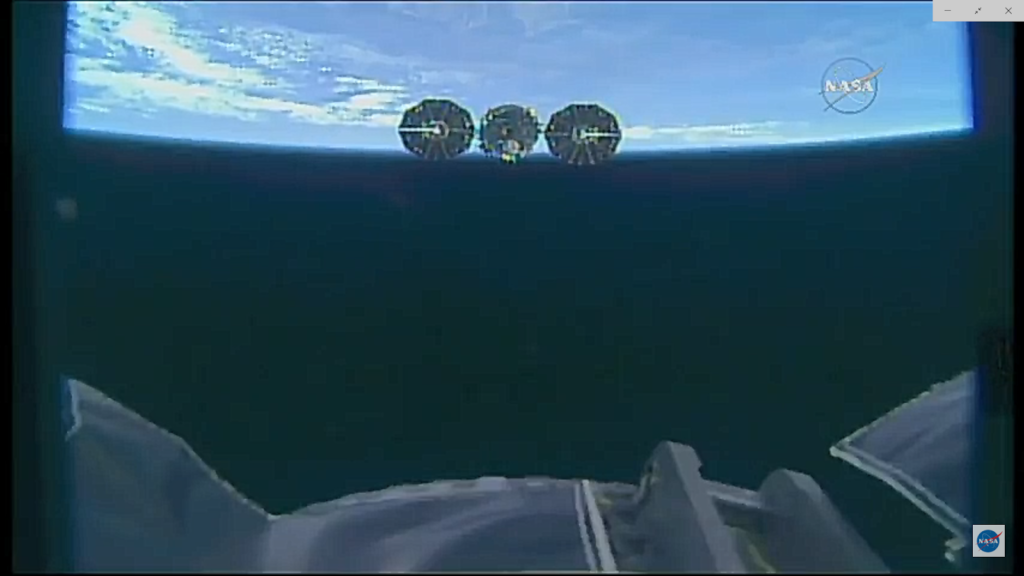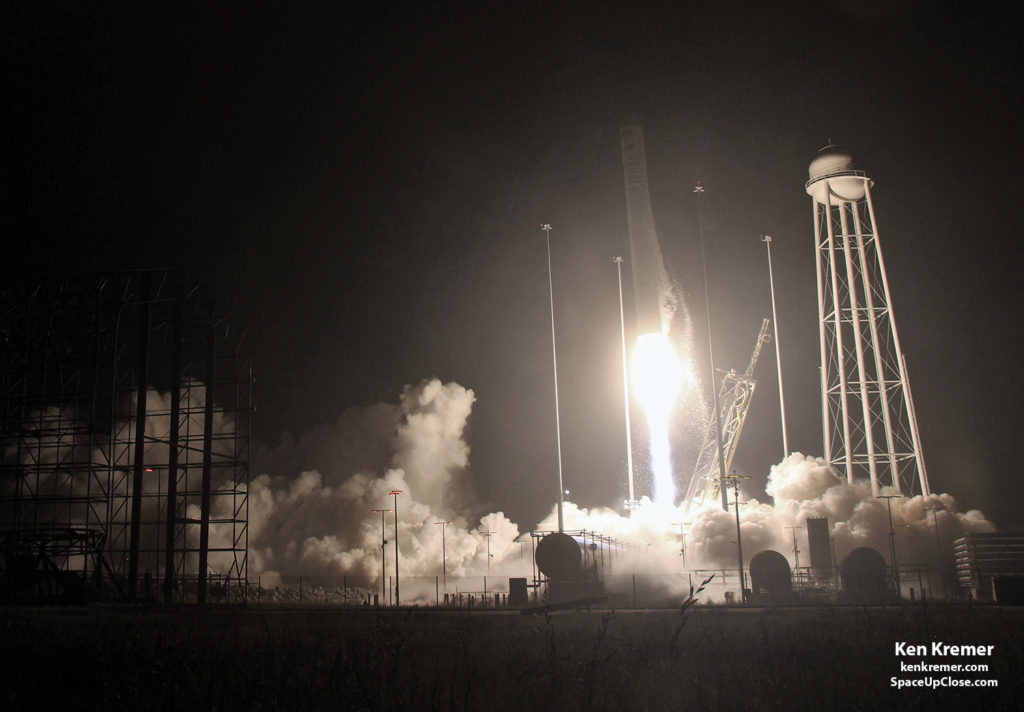 |
|
The Cygnus OA-9 cargo
craft slowly departs the space station after its release from the Canadarm2 robotic arm on July 15, 2018 . Credit: NASA TV/Space UpClose |
Ken Kremer — SpaceUpClose.com — 15 July 2018
CAPE CANAVERAL, FL – The Cygnus commercial
cargo craft departed the International Space Station on Sunday morning after
being released from the grip of the Canadian-built robotic arm under command of
the astronaut crew – after a nearly two month stay and successful delivery of
3.5 tons of science and supplies under contract to NASA.
56 Flight Engineers Alexander Gerst of ESA (European Space Agency) and Serena Auñón-Chancellor of NASA commanded the space station’s
57.7 foot (19 meter) long Canadarm2 robotic arm to release the Cygnus cargo
spacecraft at 8:37 a.m. EDT (1237 GMT).
massive orbiting outpost was soaring 253
miles (400 km) over south east Columbia at the time of the release after the
complex has just reentered orbital daylight.
 |
|
The Cygnus OA-9 cargo
craft slowly departs the space station after its release from the Canadarm2 robotic arm on July 15, 2018 . Credit: NASA TV/Space UpClose |
spectacular views as the Orbital ATK (now Northrop Grumman) Cygnus OA-9 resupply
ship slowly drifted away as the most recent SpaceX Dragon was on view and berthed
below – all backdropped by gorgeous views of the Erath below.
solar arrays came into view straddling the cylindrical Cygnus craft.
 |
|
The Cygnus OA-9 cargo
craft slowly departs the space station after its release from the Canadarm2 robotic arm on July 15, 2018 . Credit: NASA TV/Space UpClose |
the robotic arm also being maneuvered away by Gerst and Auñón-Chancellor who
were working at the robotic work station inside the domed Cupola module
commanded the opening of the snares on the latching end effector at the terminus
of the robotic arm
 |
|
The Cygnus OA-9 cargo
craft slowly departs the space station after its release from the Canadarm2 robotic arm on July 15, 2018 . Credit: NASA TV/Space UpClose |
Houston used the robotic arm to unberth Cygnus from the Earth facing nadir port
on the Node 3 Unity module nearly at the center of the station complex.
at a distance of 14.1 meters away from the station’s exterior awaiting Gerst’s
command to release the snares.
to gradually accelerate the vehicles departure.
will now carry out an extended mission lasting about 2 weeks. It is being
maneuvered to a higher altitude and position about 45 km above and behind station.
are for it to deploy 6 CubeSats from a rear mounted CubeSat deployed supplied
by NanoRacks Corp.
left that station loaded with about 6600 pounds (3,000
kg) of trash for disposal. It was
volumetrically filled to capacity said NASA.
departure command of Cygnus was handed over the Northrop Grumman Mission Control
Center in Dulles, VA, former headquarters of Orbital ATK.
will be commanded to reenter the atmosphere on July 30 for a fiery destructive deorbit
demise harmlessly over the Pacific Ocean.
performed the first American reboost of the orbiting outpost since the
retirement of NASA’s space shuttles in the maiden demonstration test of the
vehicles capabilities this week.
used to deorbit the station in a planned maneuver in the future if that becomes
necessary.
took place at 4:25 p.m. EDT (2025 GMT) on Tuesday,
July 10, and
was carried out by ground controllers at what is now Northrop
Grumman Innovation Systems mission operations center in Dulles, Virginia.
for 50 seconds on Tuesday,” Frank DeMauro, vice president
and general manager of Northrop Grumman Innovation Systems’ advanced programs
division, told Space UpClose in an interview after the maneuver.
for the full duration planned of 50 seconds.”
Flight Facility on the Virginia shore on Monday, May 21, and a three day
orbital chase, the Orbital ATK Cygnus cargo freighter arrived at the
International Space Station (ISS) early Thursday morning, May 24, loaded with
over 3 tons of critical cargo, cubesats and a host of science experiments
including the Cold Atom Laboratory.
Expedition 55 Flight Engineer Scott
Tingle captured
the Cygnus cargo
spacecraft using the International Space Station’s Canadian-built robotic arm
at 5:26 a.m. EDT May 24 as the vehicles
soared some 425 km (264 miles) over the southern Indian Ocean.
 |
|
Orbital ATK Antares rocket blasts off with Cygnus OA-9 spacecraft from Pad 0A, May 21, 2018 at NASA’s
Wallops Flight Facility in Virginia on ninth contracted cargo resupply mission for NASA to the International Space Station to deliver over 7,400 pounds of science and research, crew supplies and vehicle hardware to the orbital laboratory and its crew. Credit: Ken Kremer/kenkremer.com/SpaceUpClose.com |
in Houston at NASA’s Johnson Space Center (JSC) then took over and completed Cygnus berthing
and installation to the orbiting laboratory’s Earth-facing port of the Unity
module.
alternatively named CRS-9 or OA-9, was Orbital ATK’s ninth contracted cargo
delivery flight to the International Space Station for NASA. 11 cargo flights
are planned altogether under the initial contract with NASA.
are 7,400 pounds (3,350 kg) of cargo including science experiments, research
gear, food, water, spare parts, crew supplies and vehicle hardware to support the Expedition 55
and 56 crews.
deliver about 30,000 kilograms vital equipment, supplies and scientific
equipment to the space station as part of Orbital ATK’s Commercial Resupply
Services-1 (CRS-1) contract with NASA.
Boeing, Lockheed Martin, Orbital ATK and more space and mission reports direct
from the Kennedy Space Center, Cape Canaveral Air Force Station, Florida and
Wallops Flight Facility, Virginia.
Stay tuned here for Ken’s continuing Earth and Planetary science and human
spaceflight news: www.kenkremer.com
–www.spaceupclose.com – twitter @ken_kremer – email: ken at kenkremer.com


